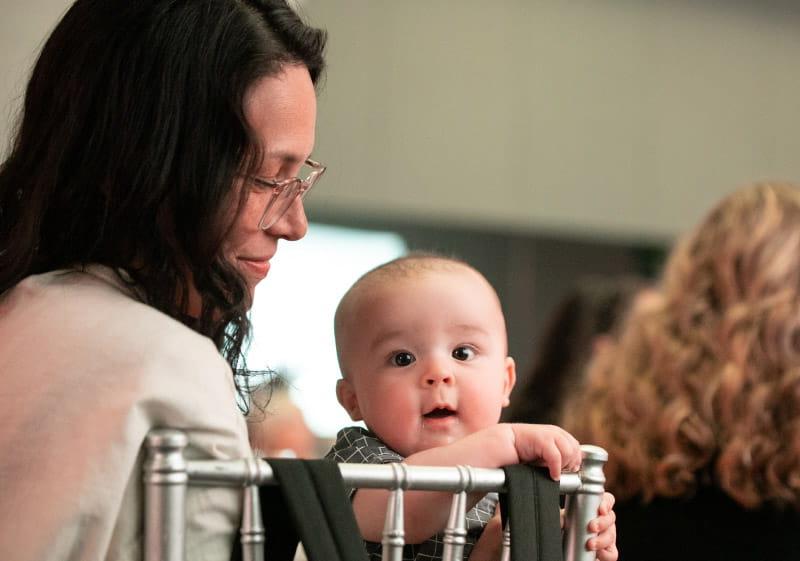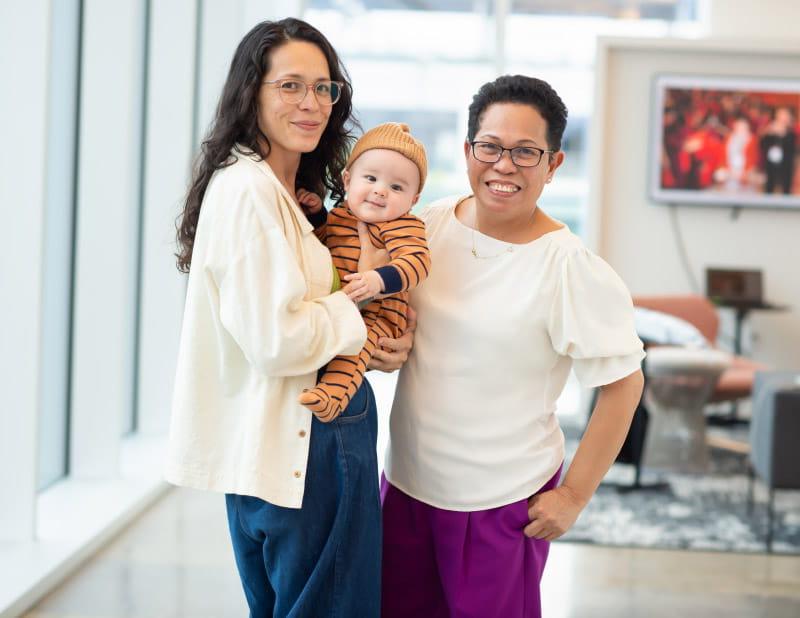Heart problem found as a teen flared in her 30s when she was pregnant
By Deborah Lynn Blumberg, American Heart Association 沙巴足球体育平台

作为一个青少年, Claire Sprouse spent hours in the ballet studio perfecting her pliés, 然后在舞台上表演. At 16, she started having chest pains.
The problem indeed turned out to be relatively minor – joints inflamed from overuse; all she needed was rest. However, something else happened during her visit to the pediatrician.
He listened to Claire's heart, then handed the stethoscope to Claire's mother, Dr. Mila Sprouse, a cardiovascular care nurse.
“你听到了吗??他说.
"That's a heart murmur," Mila said.
Further testing showed Claire's aortic valve wasn't properly closing. Because of that, blood was leaking backward into her heart. It's a condition known as aortic regurgitation.
At the time – 2001 – a common fix was to replace the valve via open-heart surgery. Claire's case was mild to moderate. Mila's gut told her surgery wasn't necessary – yet. They decided Claire would instead get annual echocardiograms, 或者心脏超声波, to keep an eye on the problem.
Still, doctors warned, she would probably be in heart failure by age 30.
Claire finished high school and went to college. 快30岁的时候, she moved from her hometown of Houston to San Francisco to start a career in hospitality. Thirty came and went and Claire's heart hadn't gotten worse. In her mid-30s, she moved to Brooklyn.
She got married and opened a restaurant, a sustainability and community-focused neighborhood spot that served American fare. Claire kept up with her annual heart tests. Each year, results were unchanged.
"Maybe you'll never need a full valve replacement," her new doctor said.
During the pandemic, Claire had to close her restaurant. 这是一个新的篇章. She and her partner, restaurateur Nico Russell, decided to start a family.
Newly pregnant, Claire called Mila with the news. She was overjoyed to have a grandchild on the way, but – knowing Claire's heart history – worried, 太.
"Tighten your seatbelt," Mila told her husband, Robert, Claire's dad.
At around four months pregnant, Claire was getting out of breath. That's a symptom of pregnancy, she told herself. But her obstetrician ordered a heart test.
The cardiologist sent Claire a message. He needed to speak with her right away.
Her valve was 太 weak to survive the pregnancy, he said. 她需要一个替代品. 现在.
“那孩子怎么办??克莱尔问.
"Talk to your obstetrician,他说.
Claire spent the next month in limbo. She had more appointments and back-and-forth conversations with doctors. She felt health care professionals weren't communicating well. No one offered a firm plan for how to proceed. It felt like a game of hot potato.
At five months pregnant, she started seeing a high-risk obstetrician. The baby was already kicking. 预约前, an electronic message with notes on Claire's case accidentally was sent to Claire. It recommended terminating the pregnancy.
Claire called Mila, then a chief nursing officer in Seattle, and broke down crying.
"I'm so sorry this happened," Mila said. “这是不可接受的. You have to put me in the middle of this conversation."
Claire emailed her doctor to say she wanted her mother, a nurse executive who specializes in heart care, 涉及到. "We got a really quick response after that," Mila said.
Claire organized a conference call with her health care professionals and her mom. They talked about open-heart surgery. It was very risky for the baby. Mila then asked about a procedure that was an alternative to open-heart surgery. It goes by the acronym of TAVR; it stands for transcatheter aortic valve replacement.
The procedure inserts a new valve into the heart through a catheter without removing the old one. It wasn't available when Claire was a teenager.
Doctors found no evidence of TAVR being done before this late in a pregnancy. It wasn't clear if Claire could have the procedure. Meanwhile, it was getting harder for her to breathe.
After additional testing, her doctors decided they could perform TAVR. Claire was five and a half months pregnant. Mila and Robert flew to Brooklyn. While Claire was in the operating room, Mila nervously walked nearby New York streets.
The procedure was so successful that Claire left the hospital the next day. Almost immediately, she breathed easier.
An ultrasound showed the baby was doing fine, 太.
Claire had a scheduled cesarean section. When she handed the healthy baby boy to Mila, Claire said: "Meet Milo." The baby was named after her.
"He's a miracle baby, our miracle baby, and there's so much in front of him," Mila said.

Claire's heart handled the birth fine. She'll continue to have annual exams. In case of emergency, she wears an ID that says she has an artificial valve.
回顾, Claire said she was lucky that she felt empowered to push for the answers and information she needed to make the best decisions.
"Part of that was help from my mom,她说, "and part of that is who I am, being a small business owner, identifying the problem and figuring out solutions. If it feels like you don't have all the information you need, you have to push for someone to give it to you. Sometimes people just aren't communicating well."

发自内心的故事 chronicles the inspiring journeys of heart disease and stroke survivors, caregivers and advocates.





